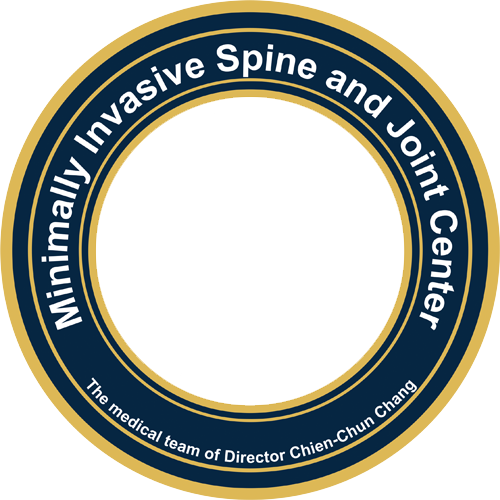0.8 cm Incision, Immediate Postoperative Mobility, and a Burden-Free Recovery
0.8 cm Incision, Immediate Postoperative Mobility, and a Burden-Free Recovery
For this passionate European tour guide, lower back pain not only disrupted his daily life but also nearly ended his career. At 70 years old, he and his wife had been leading European tour groups for many years. However, a sudden episode of acute lower back pain almost prevented him from completing a tour.
Through MRI and other diagnostic tests, Dr. Chien-Chun Chang diagnosed the patient with herniated intervertebral disc (HIVD) at the L3-L4 level, causing nerve compression. The patient experienced lower back pain, pain radiating down the outer thigh, and progressive pain while walking, a condition known as neurogenic claudication.
__25C03XouTd.jpg)
[Image: L3-L4 Herniated Disc Leading to Spinal Canal Narrowing and Darkened Appearance]
__25C038YAJv.jpg)
[Image: Sagittal View of the Herniated Disc Compressing the Spinal Canal]
The patient expressed his main concern:
"I am most worried that after surgery, I will need a long recovery period and might not be able to continue leading tours."
After a detailed consultation, Dr. Chang recommended computer-navigated minimally invasive endoscopic spine surgery, which involves a 1 cm incision to remove the herniated disc while preserving surrounding tissue and minimizing nerve and vascular injury risks. This technique allows for immediate postoperative mobility, enabling the patient to get out of bed on the day of surgery and be discharged the next day.
Endoscopic spine surgery minimizes tissue damage and results in small external wounds—one 1 cm incision for computer navigation and another 1 cm incision for the endoscope.
__25C03LbA0u.jpg)
[Left: 1 cm Computer Navigation Incision | Right: 1 cm Endoscopic Incision]
Retrospective studies published in medical journals have shown that compared to traditional open surgery, endoscopic spine surgery provides the following benefits:
- Faster return to work
- Less postoperative back pain
- Shorter hospital stays
- Reduced surgery duration
With the combination of computer navigation and minimally invasive endoscopic techniques, Dr. Chang’s team ensures precision and standardized surgical protocols, enabling patients to achieve rapid recovery with minimal incisions and maximum safety.
The day after surgery, the patient shared:
"I felt completely different the next day—my nerve compression symptoms were gone!"
One month post-surgery, he asked:
"Dr. Chang, can I go swimming?"
Dr. Chang replied with a smile:
"Of course! Stay active, and congratulations!"
Now, he and his wife are back to leading tours across Europe, sharing their journey to recovery and newfound appreciation for spinal health. Thanks to modern minimally invasive endoscopic spine surgery, patients can achieve rapid recovery without the need for extensive rehabilitation, allowing them to return to normal life quickly.
1. What is Minimally Invasive Endoscopic Spine Surgery?
This advanced surgical technique involves making a small incision to access the spine using an endoscope and high-definition imaging, allowing precise removal of the herniated disc while preserving surrounding healthy tissues.
2. How does minimally invasive surgery differ from traditional surgery?
- Minimally invasive surgery: Smaller incisions, faster recovery, and shorter hospital stays.
- Traditional open surgery: Larger incisions, longer recovery periods, and often requires extended rehabilitation.
3. Who is a suitable candidate for endoscopic spine surgery?
This procedure is ideal for patients with herniated discs, spinal stenosis, or other conditions causing nerve compression. It is recommended for individuals experiencing severe symptoms that significantly impact their quality of life, without spinal instability or fractures.
4. Is rehabilitation required after surgery?
Most patients can walk immediately after surgery and are discharged within 1-3 days. Typically, no rehabilitation is required.
5. What are the risks of endoscopic spine surgery?
Although minimally invasive spine surgery carries lower risks, potential complications include infection, nerve injury, or vascular damage. However, an experienced surgical team following standardized protocols can significantly minimize these risks.
6. How soon can I return to normal activities after surgery?
- Light activities: Within three days
- Full return to daily life: Within one month
__25C03GZJJ5.jpg)
[Recipient of the 27th National Quality Award]
Our center was awarded the SNQ National Quality Certification in 2023 and 2024, recognizing our commitment to advanced spinal care. We have established a specialized surgical team for elderly patients aged 65+ and high-risk cases, incorporating surgical risk management and multidisciplinary collaboration to ensure the highest standards of patient safety.
Through the implementation of standardized protocols for complex and geriatric spine surgery, we provide comprehensive, patient-centered medical care—achieving the highest precision, safety, and efficiency in modern spinal surgery.






